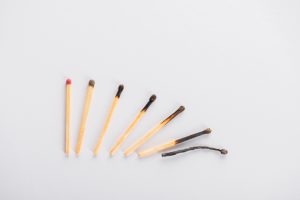By Gwen Rockwood, newspaper columnist and mama of 3
Is senioritis contagious? Because I think our nearly 18-year-old son, who will graduate high school this month, is spreading it like crazy. Our 15-year-old daughter has come down with a similar case of sophomore-itis. And lately I’ve got a debilitating case of mid-life-itis, even though Tom keeps telling me it’s not a real thing. (I say it is.)
The main symptom is a “lack of motivation,” according to the dictionary’s definition of the term. And if you could see us now, you’d nod your head like a wise old country doctor and confirm the diagnosis. After all, if it walks like an unmotivated duck and talks like an unmotivated duck, it’s an unmotivated duck. My ducks and I want to be done with everything – classes, extracurricular practices, homework, tests, events, projects, appointments, chores, deadlines – all of it.
When this lack of motivation happens to someone who is, say, 49 years old, we usually call it something like “burnout.” That’s a good word for it because lately I feel fried – mentally, emotionally, physically. My energy has burned out and left me crispy and charred around the edges.
But having a case of senioritis or burnout doesn’t make you stop doing things. Responsible students and grown-ups trudge through the day’s to-do list anyway because we must. We robotically handle the requirements of the day but not because it makes us feel better to do them. It’s just that things will be worse if we don’t.
This is the kind of condition that makes us feel hollowed out, like a well that has run bone dry. It’s not a good way for humans to be. One way or another, we need relief.
Fortunately, this collective sense of “blah” and “ugh” plaguing our house made me remember a book I read a couple years ago titled “Burnout: The Secret to Unlocking The Stress Cycle,” written by twin sisters Emily Nagoski, PhD and Amelia Nagoski, DMA.
What I liked about this book is how it uses science to explain how the mind and body deal with the stress we all experience. And it’s not just the obvious things like death or illness that cause stress. Even something like terrible traffic or a big, exciting job interview can create internal tension. So where does that tension go when the event is over? Even though our human minds know when we “should be okay by now,” our bodies hold on to this accumulated stress, storing it up like a squirrel with a hoarding problem.
In the book, the authors discuss some proven ways to “end the stress cycle” so all that backlog of tension can finally leave you in peace. The methods include things like deep breathing, laughter (not just a chuckle, a true belly laugh), affection (like a 20-second hug), doing something creative that you love, positive social interactions, and the traditional “big ol’ cry.”
If you’ve ever found yourself talking to a family member or close friend and suddenly tears are uncontrollably leaking from your eyes, your body is probably trying to end a stress cycle, whether you like it or not. It’s not always good timing, but it’s necessary. The human body has its own way of saying “Listen, something has gotta give. Like, right now.”
One of the ways to know whether you’re actually completing the stress cycle is to pay attention to what causes a shift in the way you feel. If taking a walk or a deep conversation with a friend or a tearjerker movie finally helps you feel a little lighter and more at peace, you’ll know you’re moving in the right direction. You’re releasing the pent-up steam that was burning you out.
Next week at high school graduation, I’m hoping to hug and cry and clap and cheer alongside family, friends and hundreds of other parents. I’ll be a virtual fountain of released tension. I hope it helps me and my ducklings come alive with motivation for summer break and new adventures ahead.
Gwen Rockwood is a mom to three great kids, wife to one cool guy, a newspaper columnist and co-owner of nwaMotherlode.com. To read previously published installments of The Rockwood Files, click here. To check out Gwen’s book, “Reporting Live from the Laundry Pile: The Rockwood Files Collection,” click HERE.
